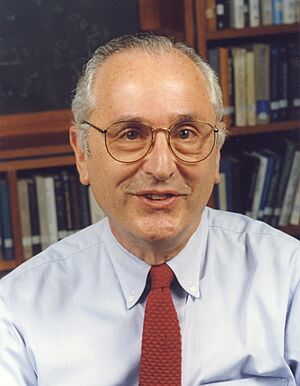John N. Bahcall facts for kids
Quick facts for kids
John N. Bahcall
|
|
|---|---|
 |
|
| Born | December 30, 1934 Shreveport, Louisiana, U.S.
|
| Died | August 17, 2005 (aged 70) New York City, New York, U.S.
|
| Resting place | Princeton Cemetery |
| Education | University of California, Berkeley (BA) University of Chicago (MS) Harvard University (PhD) |
| Known for | Solar neutrino problem Hubble Space Telescope |
| Awards | Dannie Heineman Prize for Astrophysics (1994) Dan David Prize (2003) Enrico Fermi Award (2003) |
| Scientific career | |
| Fields | Astrophysics |
| Institutions | Institute for Advanced Study California Institute of Technology Indiana University Harvard University of Chicago |
John Norris Bahcall (December 30, 1934 – August 17, 2005) was a famous American astrophysicist. He worked at the Institute for Advanced Study in Princeton, New Jersey. He was known for many important discoveries about the Sun, galaxies, and the universe. His most famous work involved solving the solar neutrino problem and helping to develop the Hubble Space Telescope.
Contents
Early Life and Education
John Bahcall was born in Shreveport, Louisiana, in 1934. When he was young, he thought about becoming a religious leader. He didn't take science classes in high school. Instead, he was a state tennis champion and a national debate champion.
He started college at Louisiana State University on a tennis scholarship, studying philosophy. He later moved to the University of California, Berkeley. There, he took his first physics class to meet a requirement. He found it very challenging but loved it. He realized that physics could explain how real things worked, like sunsets and airplanes.
John then changed his major to physics. He earned his first degree from Berkeley in 1956. He continued his studies, getting a master's degree from the University of Chicago in 1957. He received his PhD in physics from Harvard University in 1961.
After his studies, he worked as a research fellow at Indiana University. From 1962 to 1970, he worked at the California Institute of Technology.
Academic Career
In 1968, Bahcall joined the Institute for Advanced Study in Princeton, New Jersey. He became a full professor there in 1971. In 1997, he was named the Richard Black Professor of Natural Sciences.
He became a member of the National Academy of Sciences in 1976. He also served as president of the American Astronomical Society from 1990 to 1992. At the time of his death, he was president-elect of the American Physical Society.
Research and Discoveries
John Bahcall wrote over 600 scientific papers and nine books about astrophysics. His most important work was on the standard solar model. This model helps us understand how the Sun works inside.
The Solar Neutrino Problem
Bahcall spent much of his life studying the solar neutrino problem. He worked closely with chemist Raymond Davis Jr.. Neutrinos are tiny particles made inside the Sun. Bahcall's model predicted how many neutrinos the Sun should produce.
To test his ideas, Davis built a special detector underground in a gold mine in South Dakota. This detector was a large tank filled with cleaning fluid. When they measured the neutrinos, they found only one-third of the amount Bahcall had predicted. This difference was a big mystery for over 30 years.
Bahcall kept working on this problem. His research led to his book, Neutrino Astrophysics (1989). This book became a key reference for studying solar neutrinos.
In 2002, Raymond Davis Jr. and Masatoshi Koshiba won the Nobel Prize in physics. They won for their work in observing neutrinos. Their discoveries proved that Bahcall's predictions about solar neutrinos were correct.
High-Energy Neutrinos
Bahcall also worked with Eli Waxman on the Waxman-Bahcall bound. This idea sets a limit on how many high-energy neutrinos can be produced. It is based on how many high-energy cosmic rays we observe. Scientists could not fully test this idea until after Bahcall's death. New neutrino telescopes, like the IceCube Neutrino Observatory, can now detect these very high-energy neutrinos.
Hubble Space Telescope
Another big contribution from Bahcall was his work on the Hubble Space Telescope. He worked with Lyman Spitzer, Jr. from the 1970s until the telescope launched in 1990. For his efforts, Bahcall received the NASA Distinguished Service Medal in 1992.
He also brought back an old method of counting stars. This helped scientists understand the structure of our galaxy better.
Galaxy Models
Bahcall also helped create important models of galaxies. The Bahcall-Wolf model describes a galaxy with a huge black hole at its center, surrounded by stars. The Bahcall-Soneira model was used for many years to understand the structure of our own galaxy, the Milky Way. He also helped create accurate models of what happens inside stars.
Personal Life and Death
John Bahcall married Neta Bahcall, who is also an astrophysics professor at Princeton University. They met in the 1960s. They had three children: a daughter and two sons, including Safi Bahcall. John Bahcall passed away in New York on August 17, 2005. He died from a rare blood disorder.
Honors and Awards
- 2006, Exceptional Scientific Achievement Medal (posthumous), NASA
- 2004, Academy of Achievement, Golden Plate Award
- 2004, Comstock Prize in Physics from the National Academy of Sciences
- 2003, Gold Medal of the Royal Astronomical Society
- 2003, Benjamin Franklin Medal (with Raymond Davis, Jr. and Masatoshi Koshiba)
- 2003, Dan David Prize
- 2003, Fermi Award (with Raymond Davis, Jr)
- 2001, Member of the American Philosophical Society
- 1999, Henry Norris Russell Lectureship
- 1998, National Medal of Science
- 1998, Hans Bethe Prize
- 1994, Heineman Prize
- 1992, NASA Distinguished Public Service Medal, NASA
- 1976, Fellow of the American Academy of Arts and Sciences
- 1970, Helen B. Warner Prize
See also
 In Spanish: John Bahcall para niños
In Spanish: John Bahcall para niños

